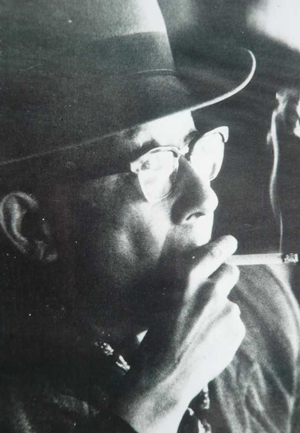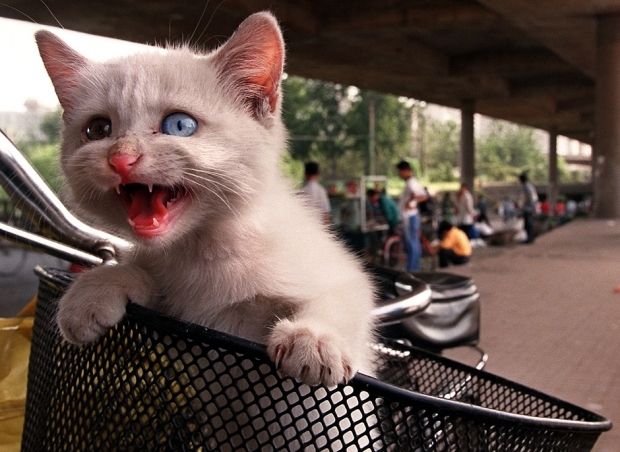In the Northwest corner of Beijing’s old city is a subway and bus workshop. It was built in the early seventies on the site of the Lake of Great Peace, which was filled in as part of a plan to extend the city’s subway system. In the bigger picture of the destruction of old Beijing, the Lake of Great Peace was just another loss—one of the countless cuts that have destroyed the old city and remade it in the borrowed image of socialism: modern, efficient, and root-less. But its demise is especially poignant because it was here in 1966 that the greatest chronicler of Beijing’s urban life, Lao She, committed suicide after being tortured and brutalized by Mao Zedong’s Red Guards.

Lao She’s best-known works are the novel Rickshaw Boy and the play Teahouse, both of which describe the challenges faced by ordinary people in China’s turbulent twentieth century. A champion of vernacular Chinese, he was one of the first to capture how people really spoke, especially the dialect of his beloved Beijing. But it’s in Cat Country that Lao She stretches himself the furthest, producing one of the most remarkable, perplexing, and prophetic novels of modern China. On one level it is a work of science fiction—a visit to a country of cat-like people on Mars—that lampoons 1930s China. On a deeper level, the work predicts the terror and violence of the early Communist era and the chaos and brutality that led to Lao She’s death at the Lake of Great Peace. Cat Country is often called a dystopian novel, but when Lao She took his own life, it was an uncannily accurate portrait of the reality around him.
The novel tells the story of a Chinese man who crash-lands on Mars. His two companions are killed and he is soon captured by a group of Cat People who run one of the planet’s many countries. After realizing that they lack rudimentary military technology, he frees himself from their clutches by using his pistol to scare them off. He is then befriended by one of Cat Country’s richest and most powerful men, Scorpion, who has a plantation of “reverie” trees, which produce addictive leaves that the Cat People eat.
Scorpion takes the narrator under his wing, protecting him from further attacks but also using him as a mercenary to guard his valuable crop. Eventually, the two go to Cat City, where the narrator learns about Cat Country’s plight. As he puts it upon entering the city, “As soon as I set eyes on Cat City, for some reason or other, a sentence took form in my mind: this civilization will soon perish!” What follows is a detailed exploration of Cat Country, which can be seen as a direct commentary on 1930s China. “Mr Earth,” as our narrator is called, views the Cat People with a mixture of pity and disgust. The locals are dirty and chaotic, the local food poisonous and unsafe, while modern education and foreign travel have only led to superficial knowledge and alienation from traditions.
The narrator’s informant is Scorpion’s son, Young Scorpion, who shows the disorderly state of museums and libraries, which have been pillaged by corrupt officials. Worse are the schools, where nothing is taught and everyone immediately handed a university diploma. In one particularly chilling scene, students dissect their teachers alive.
Unlike his great contemporary, Lu Xun, Lao She doesn’t put much hope in young people, believing them to be more hopeless than the older generation. As Young Scorpion tells our hero, “In Cat Country we don’t have any young people! We only have different age groupings…. Some of the ‘young’ people among us are even more antique in their thinking than my grandfather.”
But his criticism of China applied not only to the early twentieth century; many points ring true today. Our narrator is angered by the custom of pulling strings to get ahead—akin to the debilitating practice of guanxi that continues to hobble Chinese society. “If you had an influential friend at court, then you could rocket to the top immediately, no matter what you had studied in college,” Young Scorpion tells him.
Lao She’s era was defined by the destruction of the imperial order, as well as unrelenting attacks on traditional culture and religion. In some ways, Lao She himself participated in this; he eschewed classical Chinese for the vernacular and his writings indicate he was a strong advocate of reforming education and politics. But he also sensed the danger in these radical changes; and indeed if the country of cats is anything, it’s one morally unmoored. This rootlessness, as Young Scorpion says, “prods our people into taking a backward leap of tens of thousands of years, back to the cannibalism of antiquity.”
Lao She struggled with these issues in his personal life. Born in 1899, he was from the Manchu ethnic minority that had run China for the two hundred and fifty years prior to the empire’s collapse in 1911. That made him an outsider in China, one less bound by Han Chinese nationalism than by concern for a country that was jettisoning its traditional moral and cultural guideposts. In 1922, he converted to Christianity at Beijing’s West City New Church (Gangwashi), still one of the city’s most important places of worship.
He took the English name Colin C. Shu and taught classes in moral cultivation and music. But he seems to have stopped practicing after he grew frustrated with the lack of indigenous Christian leadership and the resulting sense that it was yet another imported ideology.
Some of Lao She’s sharpest scenes pillory young Cat People who go abroad to study and come back speaking gibberish—a sort of mock Russian that even they can’t understand. The ruling ideology is “Everybody Shareskyism,” whose leader killed the cat-emperor and installed himself at the top. One of its deities is an Uncle Karl and students in one scene cry out, “Long live Uncle Karlskyism! Long live Everybody Shareskyism! Long live Pinsky-pansky Pospos!”
When Cat Country came out, it was roundly criticized. Some of the criticism seems to reflect a lack of familiarity with satire and its inherent limitations—some wrote that the characters weren’t developed enough or that the plot was somewhat flat. Perhaps more importantly, it was at variance with the critical realism that would eventually come to smother Chinese literature. A few years earlier in 1930, the League of Left-Wing Writers had been formed, a hugely influential group that put pressure on authors to be political. But Cat Country was different. It was a blast of anger and revulsion at all sectors of society, not just the government or landlords, but also students and revolutionaries.
Lao She tried hard to fit into the new society. But almost none of his works lauded the new era of Communist rule. He candidly said that he didn’t understand the new society that Mao was building. In an interview shortly before his death, he told two foreign visitors “I am not a Marxist and, therefore, I cannot feel and think as a Beijing student in May 1966 who sees the situation in a Marxist way.”
That was an understatement. As the Cultural Revolution unfolded that spring and summer, Lao She’s sort of non-conformity became dangerous. Already sixty-seven, he was ill with bronchitis and had been hospitalized earlier. China’s canny premier, Zhou Enlai, reportedly advised him to stay put to avoid the turmoil outside, but Lao She was curious and on August 23 had himself discharged.
That same day, the Communist Party’s mouthpiece, the People’s Daily, issued an infamous editorial applauding the Red Guards’ “revolutionary spirit” and thus spurring new violence. Lao She was called out of his office at the Beijing Writers’ Union and immediately set upon by the fanatical mob. He was taken to the Confucian temple where religious relics were being burned in a bonfire. He and twenty-eight others were forced to kneel down in front of it for three hours—dubbed a “baptism by fire.” Their heads were shaved, black ink was poured on them and they were beaten. Lao She was singled out for abuse and accused of being an American agent. Accounts say he was beaten with a copper-studded leather belt until he fainted.
But Lao She refused to bend. He was released that evening and told to report to work the next day wearing the placard. When he got home, he found that his house had been ransacked, manuscripts burned and his prized collection of art strewn across the courtyard. The next day, instead of going to work, he walked to the Lake of Great Peace and sat on its shore for the day, as witnesses say. The next day his body was found floating in the waters, several of Mao’s poems scattered about.
Lao She’s death came during “Red August,” a particularly bloody period during the Cultural Revolution. That month in Beijing, 1,772 people were killed or committed suicide, calling to mind some of the chilling lines from Cat Country:
“You see, adherents of Everybody Shareskyism will kill a man without thinking twice about it.”
“And thus now it is a very common occurrence to see students butchering teachers, professors, chancellors, and principals.”
After the Cultural Revolution ended with Mao’s death in 1976, Lao She was rehabilitated. It was during this era that Cat Country was finally republished in mainland China. The author’s death is still a sensitive topic. This year, a play based on Cat Country was performed to enthusiastic audiences in several Chinese cities, but the novel continues to occupy an uncomfortable place in modern Chinese literature. While it can be seen as part of the long tradition in Chinese writing of fantastical encounters with strange peoples, its Martian setting also makes it an early work of Chinese science fiction, a genre the Communist Party has long viewed with suspicion. (In the early ’80s, science fiction was deemed to be “spiritual pollution” and most science fiction magazines closed.)
And yet appreciating Cat Country means shedding some of these labels. When Lao She describes how the emperor is replaced by the head of Everybody Shareskyism, multiple interpretations are possible—not just the role that Chiang Kai-shek was assuming for himself in the 1930s, but the fate of many revolutions, from the French to the Chinese. Equally fascinating is that in 1932, the same year Cat Country was serialized, Aldous Huxley published Brave New World and imagined a product he called “soma” that numbed his dystopian inhabitants into accepting their fate. Like “soma,” Lao She’s “reverie leaves” reflect a concern about the modern state that goes beyond the travails of 1930s China.
All of this makes Cat Country an anomaly in Chinese fiction. Lao She was deeply rooted in China, but as a Manchu he was enough of an outsider to go for the jugular when looking at his native land and to eschew the naïve belief, for example, of his great contemporary Lu Xun, that all would be well if China just trusted its youth. Lao She had a clearer view of what could beset a country when the old markers are gone, and in Cat Country he gives us a brutal look at a China we continue to see today.
Adapted from Ian Johnson’s Introduction to Cat Country by Lao She, published this month, in a translation by William A. Lyell, by Penguin Books (China) in association with Penguin Group (Australia).




